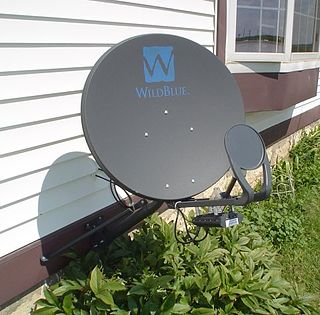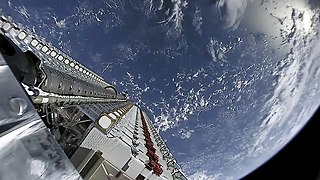
A communications satellite is an artificial satellite that relays and amplifies radio telecommunication signals via a transponder; it creates a communication channel between a source transmitter and a receiver at different locations on Earth. Communications satellites are used for television, telephone, radio, internet, and military applications. Many communications satellites are in geostationary orbit 22,300 miles (35,900 km) above the equator, so that the satellite appears stationary at the same point in the sky; therefore the satellite dish antennas of ground stations can be aimed permanently at that spot and do not have to move to track the satellite. Others form satellite constellations in low Earth orbit, where antennas on the ground have to follow the position of the satellites and switch between satellites frequently.

A very-small-aperture terminal (VSAT) is a two-way satellite ground station with a dish antenna that is smaller than 3.8 meters. The majority of VSAT antennas range from 75 cm to 1.2 m. Bit rates, in most cases, range from 4 kbit/s up to 16 Mbit/s. VSATs access satellites in geosynchronous orbit or geostationary orbit to relay data from small remote Earth stations (terminals) to other terminals or master Earth station "hubs".

Satellite Internet access or Satellite Broadband is Internet access provided through communication satellites. Modern consumer grade satellite Internet service is typically provided to individual users through geostationary satellites that can offer relatively high data speeds, with newer satellites using Ku band to achieve downstream data speeds up to 506 Mbit/s. In addition, new satellite internet constellations are being developed in low-earth orbit to enable low-latency internet access from space.
The Spaceway system was originally envisioned as a global Ka-band communications system by Hughes Electronics. When the project to build the system was taken over by Hughes Network Systems, a subsidiary of Hughes Electronics, it was transformed into a phased deployment initially only launching a North American satellite system. This is in comparison to other more ambitious systems such as Teledesic and Astrolink which retained their full global nature and which subsequently failed to complete their systems. Hughes Network Systems working with Hughes Electronics subsidiary Hughes Space and Communications completed and built the North American Spaceway system meant to provide broadband capabilities of up to 512 kbit/s, 2 Mbit/s, and 16 Mbit/s uplink data communication rates with fixed Ka-band satellite terminal antennas sized as small as 74 centimetres (29 in). The broadband Spaceway system was standardized by Telecommunications Industry Association and European Telecommunications Standards Institute (ETSI) as the Regenerative Satellite Mesh - A Air Interface.

Viasat is an American communications company based in Carlsbad, California, with additional operations across the United States and worldwide. Viasat is a provider of high-speed satellite broadband services and secure networking systems covering military and commercial markets.

Inmarsat is a British satellite telecommunications company, offering global mobile services. It provides telephone and data services to users worldwide, via portable or mobile terminals which communicate with ground stations through fifteen geostationary telecommunications satellites.
The Near Earth Network provides orbital communications support for near-Earth orbiting customer platforms via various ground stations, operated by NASA and other space agencies. It uses a number of different dishes scattered around the globe. The antennas must be able to move fast for tracking of objects in low Earth orbit (LEO). The NEN and Space Network (SN) combined were previously referred to as the Spaceflight Tracking and Data Network (STDN).

The Iridium satellite constellation provides L band voice and data information coverage to satellite phones, satellite messenger communication devices and integrated transceivers. Iridium Communications owns and operates the constellation, additionally selling equipment and access to its services. It was conceived by Bary Bertiger, Raymond J. Leopold and Ken Peterson in late 1987 and then developed by Motorola on a fixed-price contract from July 29, 1993, to November 1, 1998, when the system became operational and commercially available.

O3b is a satellite constellation in Medium Earth orbit (MEO) owned and operated by SES, and designed to provide low-latency broadband connectivity to remote locations for mobile network operators and internet service providers, maritime, aviation, and government and defence. It is often referred to as O3b MEO to distinguish these satellites from SES's forthcoming O3b mPOWER constellation.

Tooway satellite broadband Internet service available across Europe. The first version of the service was launched in 2007 via two Eutelsat geostationary satellites, Hot Bird 6 and Eurobird 3, respectively at the 13° and 33° East orbital positions.

KA-SAT is a high-throughput geostationary telecommunications satellite owned by Viasat. The satellite provides bidirectional broadband Internet access services across Europe and a small area of the Middle East, and additionally the Saorsat TV service to Ireland. It is positioned at 9°E, joining the Eurobird 9A Ku band satellite. KA-SAT was manufactured by EADS Astrium, based on the Eurostar E3000 platform, with a total weight of 6 tons. It was launched by Proton in December 2010. The satellite is named after the Ka band frequency, which is used on the spacecraft.
ViaSat-1 is a high throughput communications satellite owned by Viasat Inc. and Telesat Canada. Launched October 19, 2011 aboard a Proton rocket, it held the Guinness record for the world's highest capacity communications satellite with a total capacity in excess of 140 Gbit/s, more than all the satellites covering North America combined, at the time of its launch.
Ekspress-AM4 was a Russian communications satellite placed into the wrong orbit from a faulty Briz-M rocket stage. This satellite was to be part of the Ekspress series of geostationary communications satellites owned by Russian Satellite Communications Company (RSCC). Proposals were made to reposition the satellite to provide broadband services to Antarctica, but ultimately the decision was made to de-orbit the satellite. On 28 March 2012, the satellite splashed into the Pacific Ocean.
High-throughput satellite (HTS) is a communications satellite that provides more throughput than a classic FSS satellite for the same amount of allocated orbital spectrum, thus significantly reducing cost-per-bit. ViaSat-1 and EchoStar XVII do provide more than 100 Gbit/s of capacity, which is more than 100 times the capacity offered by a conventional FSS satellite. When it was launched in October 2011 ViaSat-1 had more capacity than all other commercial communications satellites over North America combined.

Starlink is a satellite internet constellation operated by private aerospace company SpaceX, providing coverage to over 71 countries. It also aims for global mobile phone service after 2023.

ViaSat-2 is a commercial communications satellite launched June 1, 2017 and went live late February 2018. It was advertised to be the world's highest capacity communications satellite with a throughput of 300 Gbit/s, exceeding that of HughesNet EchoStar XIX, which launched in December 2016. It is the second Ka-band satellite launched by ViaSat after ViaSat-1. The satellite provides internet service through ViaSat to North America, parts of South America, including Mexico and the Caribbean, and to air and maritime routes across the Atlantic Ocean to Europe.
A satellite internet constellation is a constellation of artificial satellites providing satellite internet service. In particular, the term has come to refer to a new generation of very large constellations orbiting in low Earth orbit (LEO) to provide low-latency, high bandwidth (broadband) internet service.
Kuiper Systems LLC, also known as Project Kuiper, is a subsidiary of Amazon that was established in 2019 to deploy a large satellite internet constellation to provide low-latency broadband internet connectivity. The name Kuiper was a company codename for the project inspired by the outer Solar System's Kuiper belt.
The Celestri Multimedia LEO System was a planned Low Earth orbit (LEO) satellite constellation, which was intended to offer global, low-latency broadband Internet services via Ka-band radio links. It was planned by Motorola circa 1997-1998 as one of the earliest "Internet in the sky" constellations, and as a successor to the company's Iridium satellite constellation, but never built or launched.
O3b mPOWER is a communications satellite system currently under construction and deployment. The first two satellites were launched on 16 December 2022 and commercial service is expected to begin "early Q2 2024". Owned and operated by SES, O3b mPOWER initially comprises 6 high-throughput and low-latency satellites in a medium Earth orbit (MEO), along with ground infrastructure and intelligent software, to provide multiple terabits of global broadband connectivity for applications including cellular backhaul to remote rural locations and simultaneous international IP trunking.










